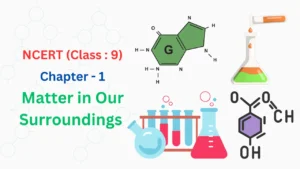
Matter in Our Surroundings
Matter:- Anything that occupy space and have mass. It is made up of atoms.
Atoms:- Tiny particle of matter.
Characteristics of particles of matter:-
- They have space between them
- Particles of matter are in constant motion
- Particles of matter attract each other known as force of attraction
- Particles of matter are very, very small
- With increasing temperature kinetic energy of particles increases .
- With increasing rate of kinetic energy, rate of diffusion also increases.
Diffusion:- Intermixing of particles of two different types of matter known as Diffusion.
State of matter:-
- Solid:- Solid has definite Shape and volume.
- Liquid :- have definite volume but indefinite Shape
- Gas:- Indefinite shape and volume
| Property | Solid | Liquid | Gas |
| Shape | Fixed | Indefinite | Indefinite |
| Volume | Fixed | Fixed | Indefinite |
| Space between particles | Very Little | Higher than Solid | Higher than liquid |
| Force of attraction | Very strong | Less than Solid | Negligible |
| Particles arrangement | Closely packed, Orderly | Disorderly | Very Disorderly |
| Movement of particles | Vibrate in fixed position | Can move | Move freely |
| Compressibility | Can’t | Almost negligible | Compressible |
| Kinetic Energy | Very low | Higher than Solid | Very high |
Another state of Matter:-
- Plasma:- It is often referred to as the fourth state of matter where atoms have been stripped of their electrons, resulting in a mixture of free electrons and ions. For example:- Sun, Stars ,Neon signs and other types of gas discharge tubes use plasma to produce light.
- Bose Einstein Condensate:-It is the fifth state of matter. Bose Einstein Condensate or BEC is formed by cooling a gas of extremely low density to super low temperatures.
Note:- Indian physicist Satyendra Nath Bose made a study regarding 5th state of matter called the Bose Einstein Condensate.
Physical State of matter can be interconverted by two way:-
- Changing temperature . For example:- if temperature lowered then gas change into liquid.
- Changing pressure. For example:- when high pressure applied to gas it compressed
For Convert Method
⚫Solid to liquid ➖ Melting/Fusion
⚫Liquid to solid➖ Freezing / Solidification
⚫Solid to gas➖ Sublimation
⚫Gas to Solid➖ Deposition
⚫ Liquid to gas➖ Evaporation / Vaporisation
⚫Gas to liquid ➖ Condensation
Example of sublimation:- Ammonium Chloride, Camphor etc
Melting Point:- Minimum temperature at which solid melt at atmospheric pressure.
Boiling Point:- The temperature at which liquid changes to gas at atmospheric pressure.
Note:- Boiling point of water is 100°c/373k
Note:- SI unit of temperature is Kelvin(k)
0°c=273 k and 0k = 273°c(absolute zero temperature)
Kelvin= °C + 273.15
Celsius= Kelvin – 273.15
Fahrenheit=1.8°C +32
Latent Heat:- Heat required to change state of substance without causing any increase in temperature.
Latent Heat of Vaporisation:- Heat needed to convert 1 kg of liquid into gas (Boiling point at atmospheric pressure)
Latent Heat of Fusion:- Heat needed to convert 1 kg of Solid into Liquid ( Melting Point at atmospheric)
Evaporation:- Liquid to gas at any temperature below its boiling point. Evaporation gives cooling effect.
Rate of evaporation increase with:-
- Increase of surface area
- Increase of temperature
- Decrease in humidity
- Increase in wind wind speed
- If amount of water in air is already high then rate of evaporation decreases.
Note:- We can boil water at room temperature at low pressure
Note:- If atmospheric pressure is high then boiling point is also high hence food take more time to cook
SI Unit:-
- Temperature:- Kelvin
- Mass:- kilogram
- Weight:- Newton
- Current:- Ampere
- Pressure:- Pascal
- Time:- Second
- Luminous intensity:- Candela
- Length:- Meter
Difference between Evaporation and Vaporization:-
| Evaporation | Vaporization |
| This is a slow and gradual process | it is a rapid and violent process |
| It take place only at surface of the liquid | It take place over the entire liquid |
| It can take place at all temperature | It takes place only at s fixed temperature that is at boiling point |
| It causes cooling | It does not produce cooling |
Effect of pressure:-
- With increasing pressure gas change into liquid.
- With decreasing pressure Solid change into gas.
Note:- Dry ice :-Solid carbon dioxide. It is store under high pressure and in low temperature.
